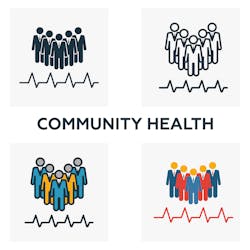A lot has changed in three years at the Raleigh, N.C.-based WakeMed Health and Hospitals. For one, as recently as 2017, the 919-bed healthcare system, with multiple facilities around the metropolitan Raleigh area, didn’t have any organized services offered for behavioral health patients. For Rick Shrum, the current vice president and chief strategy officer at WakeMed, this presented a massive opportunity for change when he took the job at the patient care organization three years ago.
Shrum, who prior to WakeMed was in the behavioral health field for 25 years, was brought to Raleigh to examine the community challenge around behavioral health and substance use conditions, and how the organization could better deal with them in the region, which was becoming one of the fastest growing areas in the U.S.
Indeed, during WakeMed’s 2017 fiscal year, emergency department (ED) visits for patients with substance use and behavioral health issues totaled more than 38,000. And days in the hospital for behavioral health and substance use patients totaled more than 12,000 during the same fiscal year. As Shrum put it, “These numbers tell the story of the need for a collaborative community effort…”
As such, the following year, a collaborative effort was formed, with the aim to create a connected community to better serve individuals with behavioral health and substance use issues. The collaboration, called the Network for Advancing Behavioral Health (NABH), looks to address the need for a coordinated outpatient care system across Wake, Johnston and Durham counties to help patients and families meet their health and wellness needs and improve outcomes.
Along with WakeMed, the NABH includes a diverse network of regional and statewide providers of psychiatric, counseling, residential, crisis, and substance use services. Today, the fruits of those labors have paid off. Organization officials point to: a 74 percent reduction in avoidable bed days and hospitalization, resulting in significant operational savings to WakeMed in the reduction in clinician, nursing, and sitter costs; a 60 percent drop in average length of stay; a 38 percent drop in behavioral health readmissions; and an estimated $30 million to $35 million in total cost of care savings to the healthcare system.
Shrum recently spoke with Healthcare Innovation Managing Editor Rajiv Leventhal about the transformation that has taken place at WakeMed. Below are excerpts of that discussion.
What was the impetus behind the creation of this behavioral health collaboration?
We have seven EDs here at WakeMed and we see over 300,000 people a year in those EDs. We were seeing that approximately 90,000 of those 300,000 of people who walked through the door had some sort of prior behavioral health or substance use condition diagnosed in their past.
Of that group, for about 30,000 to 50,000 of them, the primary reason for them presenting in the ED that day was related to a behavioral health or substance use issue. But at the time WakeMed didn’t have any organized behavioral health services in the system.
We have almost 1,000 beds, three hospitals, and 80 other locations across our market, yet we didn’t have behavioral health services. We did have roughly 140 to 160 people per day in our acute care beds, meaning these [patients presenting with a behavioral health or substance use issue] were in an acute care bed rather than in a behavioral health unit. And that’s not good for anyone.
So I told our CEO one day, around that time, we had a dramatic challenge that wasn’t getting better—we had 64 new people a day moving to Wake county—so we needed a really new big idea. That started to drive this impetus, and it started putting our WakeMed behavioral health network together.
From this initial idea, can you detail how it all came together?
A good idea is a good idea, but it’s not a great idea until you do it. Putting a behavioral health network together with disparate and unrelated organizations, and implementing a brand new idea in an integrated approach, community-wide, was really difficult.
There were a lot of different folks who have come together to pull this off: our internal WakeMed leadership team; the behavioral health teams here within the confines of WakeMed; our board of directors; and then beyond that, Wake county and the government; the state of North Carolina getting behind this effort; many other community members; and then our 30-plus partners who were pulled into this network that are participating today. Additionally, Blaze Advisors [a North Carolina-based consulting firm] was a key contributor to the development of this new connected community model.
As a result, we have been the leader and convener of a new collaborative hub for a new way forward in the field of behavioral health here at WakeMed. It’s been rewarding and challenging. We have the right culture, setup, and partners, and we’re able to speak the message in a clear enough way that people get it and are behind it. And we’re two-and-a-half years into this, so we’re just starting.
What does this picture look like now?
We have been able to put data around ideas, which allows the ideas to take a different shape and form. And that’s where [referral management solutions provider] Infina Connect comes in. What you can measure you can do something about, and you need to be able to put those measures in place in order to move the right needle. That data has created an incredible amount of interest, excitement, and opportunity for the network, some of which we thought we might be able to predict, but much of it has been unpredictable.
In a little more than two years, we have decreased the number of patients we have sent to our state hospital system by 79 percent. We have decreased our ‘days in waiting’ for patients who are medically stable but are at WakeMed waiting to be placed into treatment somewhere by 71 percent. We have decreased the amount of people that have had to voluntarily commit by about 25 percent.
How critical is getting the care coordination right for this work to be successful?
It’s a team sport. Of course, we have 24/7 EDs that are clinically led by our ED physicians and nurses. And on the behavioral health side, we have a group of 24/7 coverage [inclusive of] social workers who perform initial assessments for patients who either report that they have a behavioral health/substance use need, or the ED staff will pick up that they have a need.
So the social work staff comes in and does an assessment. If there are any question marks in that assessment between the ED staff and the social work staff, then we bring in a psychologist who also will be in the ED and gets brought in for more [complex] cases.
A big challenge is being able to understand at a deep level what this person needs to help him or her have a chance to recover and a chance at a better life. Once we know what’s going on with these patients, we then tier them on a 1 to 4 scale based on severity of illness: tier 1 is the lowest level of outpatient need and they get an appointment with one of our outpatient partners within seven days; tier 2 patients will have an appointment within 48 hours; tier 3 patients get an appointment within 24 hours; and tier 4 patients have an inpatient level of need.
We distribute those referrals based on some factors. We have an algorithm that we run and we match the patient’s need with the [outpatient] partner’s offerings. Then we match our partner’s expertise with the patient’s geography. We know that if we can deliver care to you closer to your home, you are more apt to keep accessing it.
From a care management perspective, the more severe outpatients—tiers 2 and 3—get either community case management or transition case management. So [care managers] get involved in these cases on a one-on-one basis and help patients fulfill their needs. They might need help with [finding] housing, making medical appointments, or getting medicine. We are getting them connected with those resources because we are trying to design a system of whole-person care. It’s not just about their mental illness; if they’re hungry, we’re going to help them find something to eat. We want to help those severe patients round out as much as we can.
Tier 3 patients are the hardest to impact; they’re the sickest and most complex, and when we put that care management behind them, their show rates are over 80 percent for their first appointment and over 70 percent for their second appointment. They won’t get better if they can’t access the care they need. Those numbers far exceed anything else we are seeing in industry.


